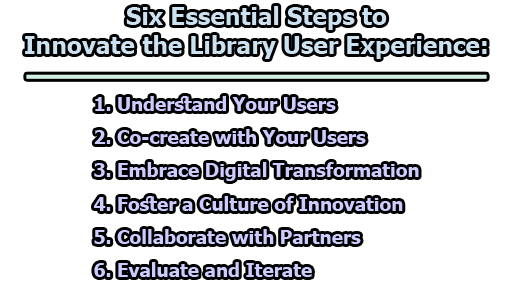Six Essential Steps to Innovate the Library User Experience:
Libraries have evolved significantly over the years, transcending their traditional role as mere repositories of books. They have transformed into hubs of learning, creativity, and community engagement. To ensure that library users have the best possible experience, it’s crucial to innovate and adapt to changing times. In this article, we will explore six essential steps to innovate the library user experience and highlight the evolving role of librarians in fostering sustainability and knowledge dissemination.
1. Understand Your Users: The foundation of library innovation lies in understanding your users. To accomplish this, libraries can conduct surveys, interviews, focus groups, or observation studies. In addition, data analytics tools can help track user behavior, preferences, and feedback. By delving into your users’ needs, expectations, and goals, libraries can design services and spaces that cater to their unique requirements.
2. Co-create with Your Users: Involving library users in the design and development process is the next crucial step. Co-creation can be achieved through workshops, brainstorming sessions, prototyping activities, or testing events. Online platforms and social media can also be leveraged to gather ideas and feedback. By incorporating user input, libraries ensure that their solutions are not just relevant but also desirable and useful to their patrons.
3. Embrace Digital Transformation: In today’s digital age, libraries must embrace technology to enhance user experience. This entails adopting digital tools and platforms that allow users to access, discover, and interact with library resources and information. Virtual reality, augmented reality, and gamification can be employed to create engaging and immersive experiences. Digital transformation helps libraries remain relevant and accessible in the digital era.
4. Foster a Culture of Innovation: Creating a culture of innovation within the library is essential to stay agile and responsive to change. Encouraging staff and stakeholders to challenge assumptions and experiment with new ideas is key. Training, resources, and incentives can help build the skills and confidence needed for innovation. A culture of innovation enables libraries to evolve alongside their users and the changing world.
5. Collaborate with Partners: Collaboration with like-minded organizations and individuals can expand a library’s reach and resources. Forming alliances, networks, or consortia with other libraries, educational institutions, cultural groups, or community agencies can be immensely beneficial. Engaging with experts, mentors, or consultants who share the library’s vision can provide guidance and support for innovation projects.
6. Evaluate and Iterate: The final step in innovating the library user experience is continuous evaluation and iteration. Measuring outcomes and impacts is essential to assess the effectiveness of innovation efforts. Qualitative and quantitative methods can be used to collect and analyze data on user satisfaction, engagement, and loyalty. Feedback loops and agile methods can be employed to test, refine, and improve library services and spaces.
The Evolving Role of Librarians: Promoting Sustainability and Environmental Awareness:
Librarians have long been seen as guardians of knowledge and champions of literacy, but their roles are evolving in response to the pressing environmental challenges of our time. They are taking on a more proactive and influential role in promoting sustainability and green policies within their communities. Initiatives such as recycling programs, energy conservation, and the promotion of digital reading materials to reduce paper waste are becoming increasingly common practices among libraries. Librarians are playing a pivotal role in fostering environmentally aware societies through educational programs and workshops focused on environmental sustainability.
- Recycling Programs: Many libraries have initiated recycling programs to reduce their environmental footprint. These programs encourage patrons to recycle paper, cardboard, plastics, and other materials within the library premises. By providing easily accessible recycling bins and raising awareness among library users, librarians contribute to reducing waste and conserving resources. The message is clear: libraries are not just about consuming resources; they are also actively engaged in responsible resource management.
- Energy Conservation: Energy conservation is another vital aspect of libraries’ efforts to promote sustainability. Librarians are increasingly focusing on making their facilities more energy-efficient. This includes adopting energy-efficient lighting, heating, and cooling systems, as well as implementing practices like turning off lights and equipment when not in use. By setting an example of responsible energy consumption, libraries demonstrate their commitment to environmental stewardship.
- Digital Reading Materials: The promotion of digital reading materials, such as e-books and online databases, is a notable trend in modern libraries. By encouraging patrons to access digital resources, libraries significantly reduce the need for printed materials. This not only minimizes paper waste but also reduces the environmental impact associated with the production and transportation of physical books. Librarians are actively advocating for the adoption of digital reading materials as a sustainable and eco-friendly choice.
- Educational Programs and Workshops: Librarians are not just changing their own practices; they are also becoming advocates and educators for environmental sustainability. Libraries are increasingly hosting educational programs and workshops that focus on topics like climate change, recycling, energy conservation, and sustainable living. These initiatives serve to inform and engage the community, helping individuals understand their role in protecting the environment and providing them with actionable steps they can take.
- Community Engagement: Libraries have always been community hubs, and this role has expanded to include a focus on sustainability. Librarians are engaging with their communities to encourage environmental responsibility. This may involve collaborating with local environmental organizations, schools, and other institutions to promote green initiatives and inspire collective action. Libraries are actively participating in community efforts to create a greener and more sustainable future.
Librarians are taking on a more active and influential role in promoting sustainability and green policies. Their efforts go beyond the traditional image of librarianship, extending into environmental stewardship and education. By implementing recycling programs, conserving energy, promoting digital reading materials, hosting educational programs, and engaging with their communities, librarians are at the forefront of nurturing environmentally aware societies. These initiatives are not only improving the library user experience but also contributing to the broader goal of creating a more sustainable and environmentally conscious world.
In conclusion, innovating the library user experience is vital in today’s dynamic environment. By understanding users, co-creating, embracing digital transformation, fostering a culture of innovation, collaborating with partners, and continuously evaluating and iterating, libraries can provide their patrons with exceptional experiences. Additionally, librarians are stepping up to play a pivotal role in promoting sustainability and disseminating valuable knowledge. These combined efforts are not only benefiting library users but also having a positive impact on society as a whole. Libraries are evolving into vibrant, forward-thinking institutions that enrich communities in diverse and meaningful ways.

Library Lecturer at Nurul Amin Degree College










